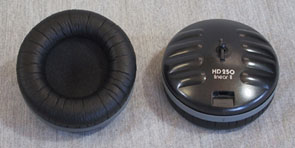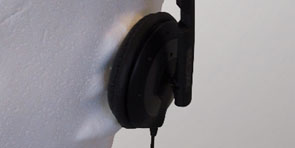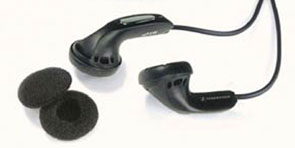

|
| Home < Products < Components < Headphones & Headsets < Selection Guide | ||||
|
Selecting Headphones (and Headsets) |
||||
|
Headphones consist of a pair of listening devices joined by a
band across the top of the head and worn in or over the ears.
They are also called earphones. A headset consists of
headphones (or earphones) with a small microphone attached to enable
two-way communication.
High quality headphones are a necessity to get the full effect of the vectorized audio generated by AuSIM's GoldServer systems. There are six possible combinations of five physical headphone characteristics: open, closed, circumaural, supraaural and intraaural. Open vs. Closed |
||||
A distinction is made between Open headphones and Closed headphones.
With closed headphones, the ear is completely sealed off from outside noise
(pressure chamber principle). Typical features of closed headphones
are the acoustically sealed housing and the ring-shaped (circumaural)
pads that completely surround the ear. The sealing around the
ear has a decisive influence on the sound reproduction of closed
headphones. If it is insufficient, the quality of the bass sounds
will deteriorate. For this reason, the contact pressure of closed
headphones is higher than that of open headphones.  The problem of sealing does not exist with open headphones, which have foam ear pads that rest on the ears, or ring pads that surround the ears. In this design, the space behind and in front of the diaphragm lets through sound. Therefore, open headphones allow sound to pass straight through the diaphragm without being "muffled", thus resulting in a more transparent and natural sound |
image. The distinguishing
features of open headphones are their small size and low weight.
These in turn make them extremely comfortable to wear, and little
discomfort is felt even after prolonged periods of listening. Open headphones are popular for normal headphone use because they sound "more natural". Further, other people can talk to you while you have them on. People who have to concentrate on what they are listening to prefer closed headphones. To allow them to concentrate on the music without disturbance from outside noise, sound engineers often use closed headphones. Closed headphones attenuate the physical aural world by 6 to 36 dB, depending on model. Open headphones attempt not to attenuate the physical world at all, but typically have a few dB of attenuation at some frequencies. |
|||
| Circumaural vs. Supraaural vs. Intraaural | ||||
There are three major types of headphone mounting styles. They
differ greatly in their effect on hearing of sound from outside. Circumaural, or "sealed," headphones form an airtight seal against the sides of the head because the headphone cup surrounds the pinnae. They greatly attenuate sound from outside. Sealed headphones are preferred in noisy environments such as an airplane cockpit. They tend, however, to be heavy, bulky, uncomfortable and sweaty. 
Supraaural, or "open-air", headphones rest on the pinnae (ear lobe), but form no seal. The conventional telephone earpiece and airline headphones are common examples. Small supraaural headphones, 2 or 3 cm across, the most common type used with portable stereos, have very little effect on sound from outside. |

Intraaural, or "in-the-ear", headphones actually have transducers mounted in the ear canal. Ear-bud headphones and hearing aids are common examples. The effect of "in the ear" headphones on sound from outside depends on their construction. Some intraaural headphones plug the ear canal, while others leave it partially open to the outside. Even a partially closed ear canal passes most sound from outside. Intraaural can be the best solution, but not always. Fitted intraaural devices (custom-molded) are positioned very accurately and consistently, and are thus best 3D audio devices. Cheap "walkman" earbuds are not as consistent. Circumaural are not as accurately positioned as fitted intraaural devices, but they are far better and more consistent than earbuds and supraaural headphones. Supraaural are the worst for 3D audio, because positional placement over the ear is very inconsistent. |
|||
| Appropriateness for an Application | ||||
|
Augmented reality is very difficult. The virtual world must precisely
match the real world, or the illusions do not work well. Generally,
open headphones work best when used in augmented reality, where a controlled
mixture of simulation and reality is needed. Closed headphones work better in a virtual reality system where we want to exclude the real world as much as possible. AuSIM3D solves a lot of the perceptual comfort issues in virtual reality with closed headphones, because we externalize the sound and make it more real. Occluding the real environment gives the VR developer complete control of the user's perception. Further, when everyone you want to talk to has a voice mapped into the virtual environment, then you will not feel isolated. AuSIMís popular HS201 closed headsets are built to fit these requirements. |
If you compare these aural head-mounted displays to visual head-mounted
displays, open headphones resemble "see-thru" HMDs (MicroVision is a good
example) while closed headphones are more like occluded HMDs (their V8 is
a good example). AuSIM has not really solved the problem of matching a virtual aural environment with a physical one. A listener of AuSIM3Dô can use and prefer open headphones for virtual environments when the physical environment is quiet and dead (non-reverberant). |
|||
|
|
||

|
[Home] [About AuSIM] [Products] [Services] [Applications] |
|
| [Support] [Contacts] [Buy Online] [Downloads] [News & Events] | ||
| © AuSIM Inc. 1998-2014. Last updated on | ||